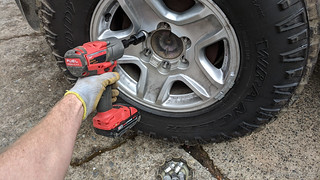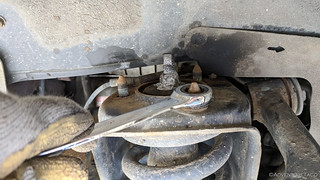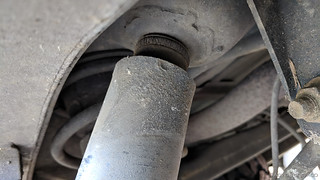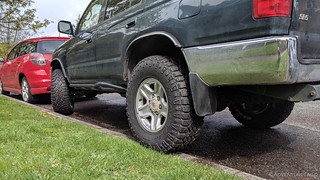April 2, 2019.
I like to think that I live and learn. I'm also a creature of habit, and I wonder if I'm starting down the same road I've been down before.
See, with the Tacoma, I thought long and hard about the first set of aftermarket suspension that I put on it. Originally I wanted to spend a couple hundred dollars. Luckily - and before I spent any money - I realized that I didn't want a block lift, I wanted a suspension lift. So then I did a bunch of research and came up with Toytec BOSS coilovers as a reasonably-priced setup - though quite a bit more than a couple hundred dollars.
And then, two years and a bunch of experience later, I ditched the Toytec setup for a high-end ADS suspension on all four corners. At a high-end price. I could have saved a bunch of money if I'd just gone that route from the start.
Fast forward to today. If the 4Runner is going to be our family adventure vehicle when @mini.turbodb is with us, it's going to need some new suspension. We'll need that to support the weight of our gear, and to provide a bit nicer ride on the bumps we'll encounter. Which immediately begs the question - do I go all-out now and put on the high-end stuff, or - like I did with the Tacoma - do I start with something else?
OK, from the title of the post, those who know about suspension know my decision - but bear with me while I explain how I ended up where I did. Because I'm starting with something else.
The reason I'm starting here - rather than going all-out - is that the plan for the 4Runner is to keep it a bit tamer than the Tacoma. We've found that full-family outings are more enjoyable when we're not wheeling all day, the small one liking to get to a cool spot and then get out and explore, rather than being cooped up in her seat. If I'm honest, I remember that feeling myself - never really caring about the things we were seeing as we drove to our camp as a kid - clearly a deficiency of human children. 
As such, I don't need the high-levels of performance, or the adjustability of a high-end racing shock. And, because family adventures are generally fewer and closer to home than some of our longer treks in the Tacoma, I don't think I'll need to worry about annual rebuilds - so that's another place I can save a few bucks.
So why then did I decide to go with Old Man Emu (OME) and not another brand like Bilstein or even Toytec again? Simple - it was for the simplicity can convenience of it all. OME has several different shock/strut options, as well as several different coil spring options that make it reasonably easy to get the performance you're looking for.
In my case, I wanted just a little bit of lift (1-2"), a little more weight carrying capacity (for our gear), and a bit of rake in the rear (the rear 1-2" higher than the front). So I ordered The following parts:
- OME 90004 Nitrocharger Sport Front Shocks - this is standard for any OEM front setup, no real option here.
- OME 2881 Front Coil Springs - these give a bit of lift in the front on a stock 4Runner, but nothing extreme.
- OME 60028 Nitrocharger Sport Rear Shocks - these have firmer valving to handle the heavier load and bumps.
- OME 2890 Rear Coil Springs - these provide similar lift to the 881 front springs, and don't require a constant additional load in the rear of the 4Runner
All that was reasonably straight forward, but there was a twist. Normally, the front shocks and coils are ordered pre-assembled. There are generally two reasons for that - first, pre-assembly includes a new top plate for the coil - a good idea if the existing top plate is rusted. Second - and more critically - most normal people make the smart decision that they don't want to deal with compressing the coils - a potentially deadly operation with the amount of force needed - to remove the old one from the old shock, and install the new one on the new shock.
That's normal people. Something I'm rarely accused of. I ordered everything unassembled. And I did it because I'd recently purchased one of these puppies! 
This Branick 7600 spring compressor allows me to compress springs safely, and I got it because I know I'll need to do that often on the Tacoma as I rebuild the suspension on an annual basis. As such, I might as well save the $100 assembly on the 4Runner as well - you know, helping to offset the cost of the Branick. That's called "flawless" male logic.
At this point, I was ready to go. Or so I thought. I got started on the front by gathering all the necessary tools:
- A few different size sockets/wrenches (though expensive this is a good kit that has nearly everything you'll ever need)
- 14mm - for the shock top mount nuts.
- 17mm - for the lower shock mount.
- 21mm - lug nuts.
- Impact wrench (or large breaker bar) - for removing your lug nuts.
- Torque wrench - to re-torque the lower shock mount and lug nuts.
I got started by jacking up the 4Runner and removing the wheel, as seems to be the case for a lot of the projects on the trucks - once again adding a smile to the long list of smiles provided by the Milwaukee impact wrench.
Next, it was time to remove the old shock from the truck. I don't know if it was the original, but if it wasn't, it was extremely old. The next few minutes would be very indicative of the rest of my day - if the various nuts came off without being cut, I'd be a much happier dude than if they'd rusted in place.
Amazingly, everything came off reasonably easy - another huge win for Pacific coast winters, and the lack of salted roads that cause everything to corrode!
With the old coil off, it was time for what was easily the most tense few moments of my day - figuring out and using the spring compressor for the first time. Would I kill myself? Only maim? Hopefully neither.
I got the spring positioned in the compressor and cranked it down. Creaking ensued. Tension (both the spring and mine) rose. And the spring compressed - it was working! I was so relieved that I forgot to snap a photo.

Soon, tension was released from the top cap and it I was able to attempt removal of the center nut that secured the top plate to the strut. It required a bit of heat, but like the other nuts, this one eventually released too - an adjustable wrench used to hold the post stationary while the nut is backed off, and off came the top cap.
And then, I was left with a little pile of death held in the spring compressor.
At this point, I figured it was a good idea to clean up the top plate a bit - while it was off the truck, I could chase the threads on the posts to remove residual rust, and then get everything ready to install the new OME 90004 Nitrocharger Sport shock into the coil.
Clean up complete, I laid out the new shock, just to ensure that I had all the parts I'd need for the install - or rather, that I knew how to install all the parts that I had (because let's be frank - it was more likely that I'd mess that up than that ARB didn't include some parts  .
.
So here's what I had: The shock itself, and then the bottom cup on which the spring sits, a new washer, new bushing, old washer, old top plate, new bushing, new washer, new top nut. Perfect.
Assembly was essentially the reverse of removal - the first step was sliding everything into the compressed spring and tightening the top center nut.
Finally, I was able to release pressure on the spring compressor and breath easily again. It had been a huge success, especially given that I hadn't had to change my underwear.
Back out at the truck with new coilover in hand, I slid it into place and loosely attached the three top nuts to hold it in place while I worked to align the bottom bolt - which of course is rarely an easy thing to do when a truck has it's OEM upper control arms (UCAs) and the stock rubber bushings on both the UCAs and lower control arms (LCAs). In the end, I resorted to a trick I'd also used on the Tacoma - the stock screw jack and a neoprene knee pad positioned in the wheel well, pushing down on the UCA, which in turn pushes down the LCA so that the lower bolt can slide in through the shock.
Not sketchy at all. Probably even the way they recommend doing it in the Toyota manual. 
At that point, I torqued everything to spec - 47 ft-lbs for the three top nuts, 89 ft-lbs for the lower bolt, and 89 ft-lbs for the lug nuts, and the front suspension was done. It was great, except that the rake on the 4Runner was now backwards - the front higher than the rear by a good amount.
Some people like it, but personally I think that looks a little goofy.
Photo © Joshua.Sindy
So it was time to do the rear. Something that would turn out to be not-quite-as-straight-forward as the front. Go figure. I started with the tools I thought I'd need:
- A few different size sockets/wrenches (though expensive this is a good kit that has nearly everything you'll ever need)
- 12mm - for the sway bar mounts.
- 14mm - for the shock top mount nuts.
- 17mm - for the lower shock mount and lateral bar.
- 21mm - lug nuts.
Eventually, I discovered that I also needed
- A sawzall.
- An angle grinder.
- A 2000 Toyota Tacoma with a winch and/or tow strap.

Unlike the front, the rear end of a 4Runner really needs to be done as a whole - you can't do one side and then the other like you can on the front - because the solid axle needs to be able to drop pretty far down in order to get the springs in/out of each side. So, the first step is to jack up the whole back of the truck and get both wheels removed. As you do this, make sure to support the frame on jack stands, and the rear diff with your floor jack - you don't want it putting too much strain on the rear brake line when you remove the shocks from the axle.
Then, to make your life much easier, I recommend removing the sway bar as well. You don't need to remove the sway bar links, just remove the sway bar itself from the rear axle - two bolts on each side - and then pull the sway bar out of the way.
You may also need to remove the lateral bar from the attachment point to the passenger side frame - that will allow you to drop the rear axle just a bit more - I needed it lower on the driver side to squeeze in the spring. Of course, that led to a minor different issue for me, but I'm getting ahead of myself.
With the truck up in the air and the sway bar (at least) removed, the next step is to remove the old shocks. The bottoms are easy - remove the single 17mm bolt and pry the shock off of the mounting post. If it gives you trouble, a pitman puller can make this an easy process.
Then, it's time for the top. And if you're anything like me, you'll be puzzled for a bit. It is not immediately obvious how to remove the top of the shock. In the end, I had to internet it.
There's no easy way to say this - Toyota really screwed the pooch here. The upper shock mounts are nearly impossible to access - they are recessed in a cup that's up next to the body, collecting dirt (and therefore rust) and stymieing any attempt to remove the top nut of the shock unless it's never gotten wet.
So the right thing to do is to cut it out. Get a grinder - or even better a sawzall - and figure out the best way to get an angle on the very top of the shock - right where it goes into the cup. The idea here is to cut the post off of the top, so that the shock falls to the ground, and you can just pull the post out of the cup.
For me, that meant unclipping several of the ABS sensor wire clips and moving that away from the cutting area. Only then did I feel confident that when I used the sawzall on the driver side and the grinder on the passenger side, that there wasn't anything in danger of being cut that shouldn't have been.
A bit of burning-rubber-stink later, and you should have the shock free from the upper mount - the shock body will fall to the ground, and you can retried the top of the post from the cup (along with a bunch of dirt). Laying everything out, this is what I ended up with:
Knowing I was close to getting everything disassembled, I plowed ahead - lunch be damned. The old springs were pretty well shot - likely the original on the truck - and so it didn't take much effort to angle the rear axle a bit in order to slide them out.
From there, it was a reasonably simple matter of re-assembly in the reverse order. I pulled the bump stops out of the old coil springs and inserted them into the tops of the new springs before forcing the new springs into position on the rear axle. This was the point where I needed the lateral bar in order to get the driver side of the axle to drop low enough to fit the new spring, but it went easily enough once that was done.
Then, the new shocks simply bolt in place - the only thing to be careful of is that you've got all the parts installed in the right order: lower bushing in the lower eye of the shock; shock, capture washer, bushing, capture washer (with small lip), <evil vehicle cup mount>, bushing, capture washer, top nut.
I found it easiest to install the shock on the lower mount first (torque to 72 ft-lbs), and then to release the compression clamp that it shipped with. As the shock uncompressed, guide it up into the evil cup mount at the top of the frame, and then slide the second bushing and capture washer on before tightening down the top nut until it bottoms out.
Then, re-attach any ABS clips you've removed as well as the sway bar (assuming you're keeping the sway bar on your truck). Finally, grab the 17mm bolt that holds the lateral bar in place and re-insert and tighten it to spec (72 ft-lbs).
Or, in my case, don't.  For the life of me, I couldn't get the holes to align. I tried several different things ranging from ratchet straps to the floor jack to get them back into alignment, eventually wondering, "Wonder what happens if I drive it without it being attached? Probably the axle slides out of the truck. Cool."
For the life of me, I couldn't get the holes to align. I tried several different things ranging from ratchet straps to the floor jack to get them back into alignment, eventually wondering, "Wonder what happens if I drive it without it being attached? Probably the axle slides out of the truck. Cool."
But then, I realized I had a hammer for every screw. I pulled out the Tacoma and hooked up a tow strap. That was more than enough force to pull everything back into place!
And with that, I was done. New suspension all around on the 4Runner - now, one step closer to family adventure vehicle, and also ready for an alignment. And alignment that still needs to happen, now three weeks later!
Say it with me now... what. a. slacker.





























Are you happy with the ride and rake when fully loaded? Looking for a mild lift/ restore on my 99 with a tent and a similar back setup.
Thanks!
Hey Kyle, the suspension does a fine job of holding weight when the 4Runner is loaded. I am happy with it from that perspective. The ride does seem stiff to me, especially when unloaded, and especially in the front.
I think a big part of the reason for that is that an OME setup is a mid-level suspension, so I’m comparing it to the ride from stock (which is obviously much softer), and a higher end suspension like ADS, which I have on my Tacoma and is tuned to the truck.
If I were to do it again, I’d probably go with a Bilstein setup in the hopes that it would be a little better behaved, though I’m not sure it would make a difference.
Hope that helps!
Hi Dan,
So I’m trying to picture this in my mind: how would you do this differently if the spring and shock had come pre-assembled? Is there something that impedes the spring from becoming fully extended before you install it? If not, how would you compress it to make it fit at the bottom?
Also, you mentioned in another comment that you’d “probably go with a Bilstein setup in the hopes that it would be a little better behaved...” So you think that the ride would be a bit softer than with the OME setup? The reason I ask is that I’m going to do a tame lift, 1” to 2” max, but I’m being realistic: I’m not going to be off-road even 10% of the time/mileage, and I want it to be comfortable yet capable. (I’m nearing senior citizen age, so that’s important to my aching bod.). Got any recommendations?
Thanks,
Ken
Hey Ken,
The spring, even when the shock is fully extended - is longer than the shock (or the part of the shock over which it sits) and has to be compressed in order to be installed. You can do this with
As for getting the coilover installed in the truck, pressing down with the bottle jack is actually a common method. The bushings in the upper and lower control arms are what prevents "easy" installation of a coilover, and an alternative would be to loosen all the bolts holding each of them in. That however is more of a pain than just using the jack to push the upper control arm (and by extension of the spindle, lower control arm) down in order to make room for the shock.
As far as ride goes, I think the Bilstein 5100 at their lowest lift setting, with some Eibach springs in the ~550-600lb range (definitely not heavier than that) would be a good setup and provide a nice ride. Or, if you want something even nicer, and don't feel the need for a lift, then Bilstein 4600 would fit the bill nicely.
That’s great info, Dan. Two questions.
In your last paragraph of your response, when you say, “ Or, if you want something even nicer,” do you mean that the 4600 is softer feeling?
When doing a modest lift of 1” or so, is it common practice to lift the front more than the rear? I definitely don’t want a higher front than rear. I’d like a slight rake. Nothing drastic.
Yeah, when I say "nicer," I really mean "softer riding." The 4600 is basically a stock replacement shock, so you'll have essentially the ride designed by Toyota when the 4Runner rolled off the line.
One thing that's important to remember is that when you replace the springs and shocks up front, you'll almost always "feel like" you lifted the truck - assuming you're running original (or worn out) components there before the replacement. Often times, those sag about 1.5-2" already, so just getting back to stock height is a "step up."
As for lifting the front more than the rear - I think the answer is that it depends. Some people like the look of a leveled truck, or even one where the front is higher than the rear. Personally, I'm not a fan of that, I like the rear higher than the front. But, like I say, it's just a matter of opinion. Some people like lowered trucks too, but that's not my thing either. ?
Thank you for your thoughtful reply, Dan.
If I may, I wasn’t asking about preference when it comes to high/low front/rear. Perhaps I crafted that question sloppily. I was inquiring about if it is the rule or common practice to lift the front more than the rear when replacing shocks and springs. Is that the case because of the weight of the engine in contrast to the heaviest thing in the back, the axle? Or does one just raise them equally? Or does one go with the obvious, and that is if I want the rear 1” higher than the front, then I will just raise it 1” higher?
Hey Ken, I tried to address that in the last paragraph of my previous reply when I started off with "it depends." The thing about lifting (or lowering) a truck is that it's all about preference. There is no "right" or "the rule." From my experience, it is common practice to lift a truck so that the front is still lower than the rear (which means raising the front and rear equally), so that it is level with the rear (raising the front slight more than the rear), and so that it is higher than the rear (raising it much more than the rear) - all dependent on personal preference.
Hope that makes it clearer!
That did it. So on a stock vehicle, the rear is slightly higher than the front, so any replacement gear should be installed at the same level.
Thanks for being patient and using nice, small words!